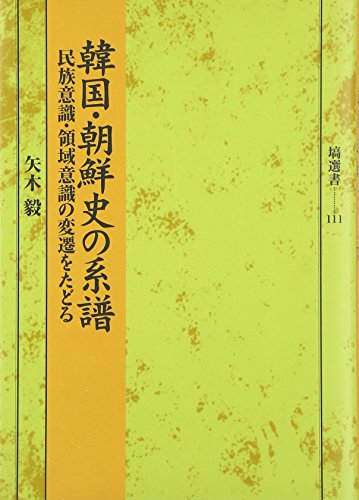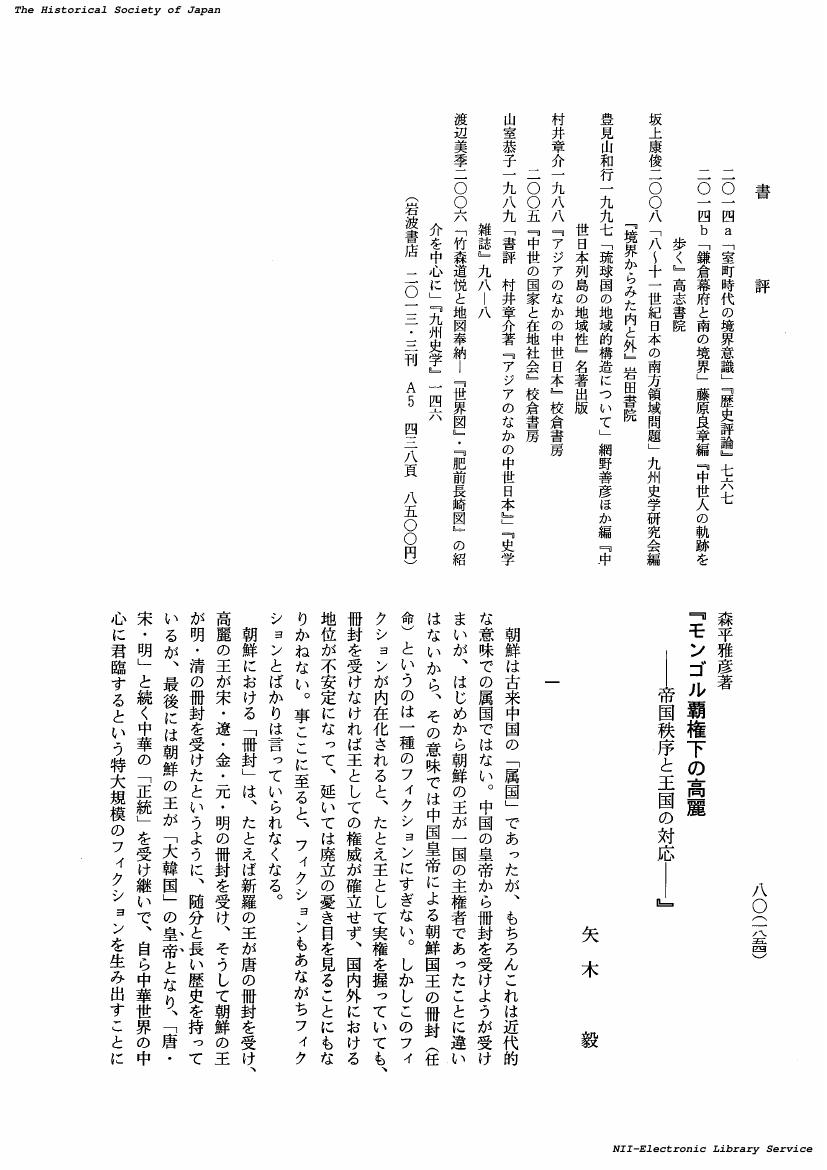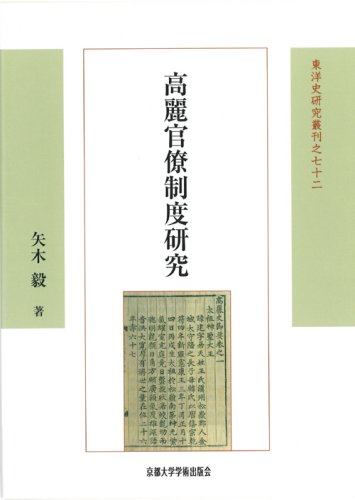14 0 0 0 OA 近世朝鮮時代の古朝鮮認識 (特集 東アジア史の中での韓國・朝鮮史)
- 著者
- 矢木 毅
- 出版者
- 東洋史研究会
- 雑誌
- 東洋史研究 (ISSN:03869059)
- 巻号頁・発行日
- vol.67, no.3, pp.402-433, 2008-12
Behind the use of Joseon, the early-modern country's name, was the consciousness that the country was the legitimate successor of Dangun Joseon 檀君朝鮮 and the ancient state of Gija Joseon 箕子朝鮮, which were thought to have actually existed in ancient times. The legends of Dangun Joseon and Gija Joseon are each indivisibly tied to the area of present-day Pyeongyang, and Seoul, the new capital of the Joseon dynasty, had from olden times been known as Pyeongyang of the South. Pyeongyang had flourished as the seat of government of Nangnang 樂浪郡 district, but with the southern advance of Goguryeo, Nangnang was destroyed and a temporary seat of government 僑郡 for the region was established in Liaodeng/Liaoxi 遼東・遼西 area. Pyeongyang once again flourished as the capital of Goguryeo, but with the Tang dynasty's destruction of Goguryeo, exiles streamed into the Liaodeng/Liaoxi region. These people brought with them to Liaodeng and Liaoxi the memory of the land around Pyeongyang that symbolized past glories and legend of Gija Joseon, which was inextricably tied to the Pyeongyang region. The people of early-modern Joseon who later "discovered" the legend came to see precisely this as proof of Gija Joseon's control of Liaodeng/Liaoxi, and came to argue that Gija Joseon had moved from Pyeonyang of Liaoxi, to Pyeongyang of Liaodeng, and finally to Pyeongyang of the Korean peninsula. This image of the territory of Gija Joseon, of course, overlapped with that of the territory of the Joseon kingdom of Dangun, the progenitor of the people. In this manner the image of the territory of the Ancient Joseon 古朝鮮 dynasties was "proven" through the records in the Chinese histories for early-modern Joseon.
7 0 0 0 IR 近世朝鮮時代の古朝鮮認識 (特集 東アジア史の中での韓國・朝鮮史)
- 著者
- 矢木 毅
- 出版者
- 東洋史研究会
- 雑誌
- 東洋史研究 (ISSN:03869059)
- 巻号頁・発行日
- vol.67, no.3, pp.402-433, 2008-12
Behind the use of Joseon, the early-modern country's name, was the consciousness that the country was the legitimate successor of Dangun Joseon 檀君朝鮮 and the ancient state of Gija Joseon 箕子朝鮮, which were thought to have actually existed in ancient times. The legends of Dangun Joseon and Gija Joseon are each indivisibly tied to the area of present-day Pyeongyang, and Seoul, the new capital of the Joseon dynasty, had from olden times been known as Pyeongyang of the South. Pyeongyang had flourished as the seat of government of Nangnang 樂浪郡 district, but with the southern advance of Goguryeo, Nangnang was destroyed and a temporary seat of government 僑郡 for the region was established in Liaodeng/Liaoxi 遼東・遼西 area. Pyeongyang once again flourished as the capital of Goguryeo, but with the Tang dynasty's destruction of Goguryeo, exiles streamed into the Liaodeng/Liaoxi region. These people brought with them to Liaodeng and Liaoxi the memory of the land around Pyeongyang that symbolized past glories and legend of Gija Joseon, which was inextricably tied to the Pyeongyang region. The people of early-modern Joseon who later "discovered" the legend came to see precisely this as proof of Gija Joseon's control of Liaodeng/Liaoxi, and came to argue that Gija Joseon had moved from Pyeonyang of Liaoxi, to Pyeongyang of Liaodeng, and finally to Pyeongyang of the Korean peninsula. This image of the territory of Gija Joseon, of course, overlapped with that of the territory of the Joseon kingdom of Dangun, the progenitor of the people. In this manner the image of the territory of the Ancient Joseon 古朝鮮 dynasties was "proven" through the records in the Chinese histories for early-modern Joseon.
2 0 0 0 韓国・朝鮮史の系譜 : 民族意識・領域意識の変遷をたどる
1 0 0 0 IR 高麗における軍令権の構造とその変質
- 著者
- 矢木 毅
- 出版者
- 京都大學人文科學研究所
- 雑誌
- 東方学報 (ISSN:03042448)
- 巻号頁・発行日
- no.70, pp.291-327, 1998-03
- 著者
- 矢木 毅
- 出版者
- 公益財団法人 史学会
- 雑誌
- 史学雑誌 (ISSN:00182478)
- 巻号頁・発行日
- vol.123, no.10, pp.1854-1863, 2014-10-20 (Released:2017-07-31)
1 0 0 0 OA 高麗における軍令權の構造とその變質
- 著者
- 矢木 毅
- 出版者
- 京都大學人文科學研究所
- 雑誌
- 東方學報 (ISSN:03042448)
- 巻号頁・発行日
- vol.70, pp.291-327, 1998-03-27
1 0 0 0 IR 朝鮮時代における死刑囚の再審制度 : 詳覆・三覆啓と淸朝の秋審
- 著者
- 矢木 毅
- 出版者
- 京都大學人文科學研究所
- 雑誌
- 東方学報 = Journal of Oriental studies (ISSN:03042448)
- 巻号頁・発行日
- vol.90, pp.145-171, 2015-12
In Joseon Korea, only the king could pass a sentence of death and give the order for the execution of condemned criminals ; because of this, he would take great care in such legal proceedings. In particular, he would order the Board of Punishments to examine a case and the State Council to re-examine it before he approved a sentence of death. Moreover, he would order treble retrials before he approved the execution of condemned criminals. These proceedings were taken from the system described in the Confucian classics. The second of the treble retrials was just a screening, so substantial deliberation only occurred in the first and third retrials. Besides, it was not uncommon that the proceedings of treble retrials were completely skipped over. First, these proceedings were not followed in wartime cases. Second, trials for felons were conducted by the officials of the "three departments, " who acted on behalf of the king himself. Therefore, the king received full information from the "three departments, " so there was no need for him to re-examine a case. Finally, condemned criminals, for whose crimes immediate execution was prescribed in the penal code, were immediately executed in the late Joseon period, even though the procedure of the treble retrials was originally required by the law. The sovereignty of the king, however, was restricted in the case of "border crossings." Condemned criminals who had committed a crime in China and had been arrested in Korea were executed only after the emperor of the Qing dynasty approved their execution. Therefore, Joseon Korea could be called a dependent of China in terms of legal proceedings.
1 0 0 0 朝鮮時代の有旨書状について
- 著者
- 矢木 毅
- 出版者
- 朝鮮学会
- 雑誌
- 朝鮮学報 = Journal of the Academic Association of Koreanology in Japan (ISSN:05779766)
- 巻号頁・発行日
- vol.241, pp.55-84, 2016-10
1 0 0 0 東アジアにおける法と習慣-死刑をめぐる諸問題
「東アジアの法と社会」という研究題目の下、4年間に渡って続けてきた我々の共同研究の成果として、以下の成果を報告する。第一は、国内国外で二度にわたって国際シンポジウムをおこない、東アジアにおける空間的、時間的座標のうえに死刑・死罪を考え、各時代、各地域の相違が浮き彫りにされたことである。その適用理念は、応報にあるのではなく、一に予防と威嚇にあることである。それは今日の中国の死刑に実態をみれば、罪と罰が均衡をかくこと、死刑廃止の議論が希薄であることからもわかる。各担当者の課題を深めて論文にした当研究の成果報告『東アジアにおける死刑』(科学研究費成果報告:冨谷篇)において、かかる東アジアの死刑の歴史的背景、本質が明らかにされている。報告書には、スウェーデンのシンポジウムには、参加できなかった藤田弘夫、岩井茂樹、周東平の各論考の収録し、社会学の視座からの死刑問題の考察、現代中国の死刑制度をテーマとする。さらに報告書は、さきの平成15年のセミナーの報告も加えたもので、英語でなされたセミナーの報告は、英文で、その後の主として日本側の研究分担者、および周東平論文は日本語で掲載している。なお、本研究のさらなる成果として、京都大学学術出版会から、平成19年に『東アジアにおける死刑』(仮題)を出版する予定である。我々の研究成果が今日の日本の死刑問題を考える上で、寄与できるのではないかと自負している。
1 0 0 0 本邦に残存する朝鮮渡来漢籍の調査・研究と保存的利用法の開発
朝鮮渡来漢籍の調査を行うのが目的であるが、今回は特に対島の宗家が所蔵し、厳原の長崎県立対島民族資料館に寄托されている漢籍と朝鮮版漢籍の調査をおこなった。その結果これらの典籍は、17世紀の中葉約50年間の間に渡来したものであり、ことにこの時期に朝鮮で出版された漢籍が集中的かつ良好に保存されている、極めてめずらしいケースであることが判明した。続いて建仁寺の両足院に保存されている対島府中の以酊庵(いていあん)関係文書(朝鮮との外交文書)・地図と南禅寺金地院文書(以酊庵に輪番として派遣された五山僧の記録)の全貌を把え、全文書を撮影した。これは研究者にとって極めて貴重な基礎資料となるものである。続いてカリフォルニア大学バークレイ校の東アジア図書館で調査し、旧三井文庫(新町三井)等わが国から当地に流出した資料約3000点を見出した。折りよく在外研究にめぐまれた九州大学の松原孝俊教授に紹介し、同教授によって調査が進められている。その結果も本研究に反映しうる。次にこうした資料をウェブによって公開利用に供するためのシステムを開発した。現在島根県立大学で試験的に運用しているウェブ・リトリーバル・システムがそれであって、このシステムによって、内外の諸機関のデータベースと相互に検索を行い、ウェブ上で検討に付することが可能になった。これも研究による大きな成果である。そのURLは以下である。http://ekanji.u-shimane.ac.jp/webusers/jsp/xmlweb/databases.jsphttp://nohara.u-shimane.ac.jp/dicl 204/dic-index.html


